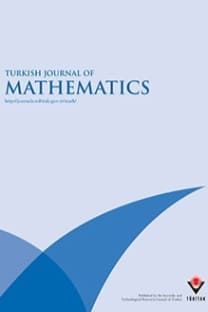Two Lemmas on Formal Power Series
Let L be a local field and \tilde{L} the completion of the maximal unramified extension of L. In this short note, we prove \noindent (I) the sequences \noindent (1\prime\prime) 0\rightarrow {\cal O}L[[X1,\ldots,Xn]]\rightarrow{\cal O}\tilde{L}[[X1,\ldots,Xn]] \stackrel{fL-1}{\ra}{\cal O}\tilde{L}[[X1,\ldots,Xn]]\rightarrow 0 \noindent and \noindent (2\prime\prime) 1\rightarrow {\cal O}L[[X1,\ldots,Xn]]x\rightarrow{\cal O}\tilde{L}[[X1,\ldots,Xn]] x\stackrel{fL-1}{\ra}{\cal O}\tilde{L}[[X1,\ldots,Xn]]\rightarrow 1 \noindent are exact, where qL is the Frobenius automorphism over L applied on the coefficients of {\cal O}\tilde{L}[[X1,\ldots, Xn]], and qL-1 respectively denotes the mapping a\mapstoaq L-a for \noindent (1\prime\prime) and e\mapsto\frac{efL}{e} for (2\prime\prime); \noindent (II) {\cal C}\circ(\tilde{L},h) being the group the Coleman power series of degree 0, the sequence 1\rightarrow {\cal C}\circ(L, h)\rightarrow{\cal C}\circ(\tilde{L},h)C\circ(\tilde{L},h) \rightarrow 1 \noindent is exact, where {\cal C}\circ(L,h)={\cal O}L[[X]]x\cap{\cal C}\circ(\tilde{L},h)
Two Lemmas on Formal Power Series
Let L be a local field and \tilde{L} the completion of the maximal unramified extension of L. In this short note, we prove \noindent (I) the sequences \noindent (1\prime\prime) 0\rightarrow {\cal O}L[[X1,\ldots,Xn]]\rightarrow{\cal O}\tilde{L}[[X1,\ldots,Xn]] \stackrel{fL-1}{\ra}{\cal O}\tilde{L}[[X1,\ldots,Xn]]\rightarrow 0 \noindent and \noindent (2\prime\prime) 1\rightarrow {\cal O}L[[X1,\ldots,Xn]]x\rightarrow{\cal O}\tilde{L}[[X1,\ldots,Xn]] x\stackrel{fL-1}{\ra}{\cal O}\tilde{L}[[X1,\ldots,Xn]]\rightarrow 1 \noindent are exact, where qL is the Frobenius automorphism over L applied on the coefficients of {\cal O}\tilde{L}[[X1,\ldots, Xn]], and qL-1 respectively denotes the mapping a\mapstoaq L-a for \noindent (1\prime\prime) and e\mapsto\frac{efL}{e} for (2\prime\prime); \noindent (II) {\cal C}\circ(\tilde{L},h) being the group the Coleman power series of degree 0, the sequence 1\rightarrow {\cal C}\circ(L, h)\rightarrow{\cal C}\circ(\tilde{L},h)C\circ(\tilde{L},h) \rightarrow 1 \noindent is exact, where {\cal C}\circ(L,h)={\cal O}L[[X]]x\cap{\cal C}\circ(\tilde{L},h)
